This is a bit off the regular beaten path of categories usually posted here, but here goes…
We took a drive the other day on the back side of Alegras Mountain just because we had not been there before. From Google maps I had seen a rather strange formation on the side of one of the peaks attached to the main mountain mass, and had wanted to explore it more closely. As it turned out, it was somewhat different from what I expected, as we really started on the southwest side.
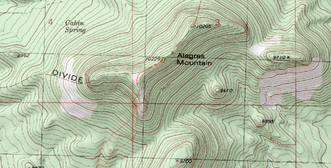
This all started when I was looking into a path to climb Alegras Mountain, and the ways and means to do so. Please note that I am not much for extended hiking, and never have been overly enthusiastic for scrambling over extreme terrain in remote areas, unless there is something really worth exploring.
GPS1 is a very useful tool for not only tracking a trek, for example, but also for planning a trek! There is only one really good place to access Alegras Mountain without running into trespassing issues, and that is on the west side of Alegres from Dipping Vat Road. The reason is there is a small corner of Dipping Vat that crosses state land, thus allowing access. The formation which caught my eye looked like a shadowed door into the side of a cliff. Interesting! I should keep in mind that at different times of the day, shadows can play tricks on the eye, and show things that may not be real.
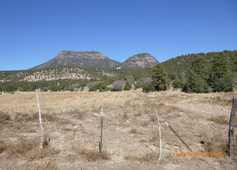
So, after positioning ourselves at what we thought was a good starting point, we took off! The terrain, per Murphy’s Law, was all uphill! But we had plenty of water! We had barely started when a group of javalina around a small pool in a creek bed saw us and very speedily disappeared into the brush. That was exciting! The scenery was most beautiful and interesting, as we saw small herds of Elk, and one tiny group of mule deer that seemed in no way afraid of our presence. In fact, they just stood and looked at us as we went on our way. It was like they had never seen humans before and so weren’t startled into flight. The terrain became rougher and showed more than the beginning flora of juniper and pi
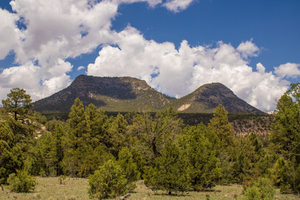
As we moved on, the terrain became even rougher and much steeper, but also more beautiful. Also, the forest became thicker and visibility much less. Soon we stumbled upon what we thought looked like a trail and decided to follow it. It wound through the trees and led us closer to the rocks we could glimpse through the trees. Soon it was actually following a rock cliff face as it curved around the mountain. The trees grew up against the granite in many places, so we had no option but to squeeze through between the rock and tree trunks. However, the path seemed to be clear and easy to follow, so we continued on.
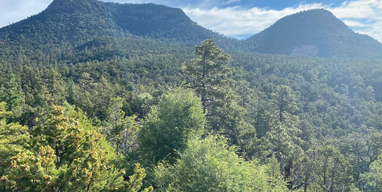
At several points on the journey, the path seemed to have been chiseled from the rock into crude steps, but of a size that was uncomfortable for us, but seemed to be for a person with a much larger stride. But perhaps whomever made the steps had determined to make less steps for easier excavation, rather than for a larger person. That seemed to make sense as some of the steps were two feet high and about three to four feet deep. As the way continued, the path became steeper and some of the steps became more like holes found in some Anasazi ruins and cliff dwellings, but of a much larger size. Also the spacing seemed a bit much, at least for our climbing. In fact, some of the holes were so far apart, we had to really stretch to reach them, so did not feel safe perched on the side of the cliff. Fortunately, the cliff was not sheer, but sloped at about 50o. However, we soon began to realize we would most likely not be able to return the same way, as going down the slope would not be a pretty prospect as we would be going backwards, hardly able to see the holes easily because of the excess spacing between.
After climbing this way for about 200 yards, we ascended above the granite layer, which then became looser rock where we had more opportunities to maneuver among the boulders. However, the path did become narrower and much more serpentine as we climbed higher. At least we didn’t feel we were in as much danger of falling. Finally, we came to a weird flat area, as we rounded a boulder the size of a house. It seemed odd to find such a place on the side of the mountain, as it could not be seen from any distance, and we hadn’t seen anything like this from the Google pictures we had examined. We neglected to take any pictures, as we were at this point, dead tired, thirsty and hungry. So we decided to take the opportunity to break for an early lunch.
After we had eaten our chicken salad sandwiches and tortilla chips, we decided to push on. The trail we followed continued off the other side of the flat area, but seemed to be descending. We almost decided to find another route as we needed to go up! But we continued until we came upon a giant boulder split in twain as if a knife had cleaved it. It looked a tad scary as the two pieces seemed none too stable, but the path continued that way, and there was no other way around as there was a drop off on one side and a cliff face on the other. But then, as we squeezed between the two pieces of the huge split boulder, we found the trail again ascended higher. So, we were again climbing, and the path was once again in good shape, as if someone had cleaned and repaired it numerous times. There were some areas that seemed to be filled with some sort of grout, but much smoother and shinier, almost like powdered crystal shards, not like modern mortar or cement. There were some of the outer edges of the steps sheared off, most likely from falling rocks in past times. So it seemed the repairs were from perhaps hundreds of years prior, but I am no geologist!
At this juncture, we realized we were way off from our intended path, and nowhere near the top of Alegras. Somewhere during our trek through the thick forest, we had deviated from our intended route, and were about a mile further east of where we wished to go, but still far up, altitude wise. We could even see, in the very far distance, our little ranch. At this point, as we had expended a huge amount of effort getting to where we were, we decided to just continue on the path to see where it led, at least for a while.
At this point, I have to say what I think happened to create the Alegras mountain as it is today. I think, without much evidence, Alegras may have been a volcano in ancient times that exploded, blowing out the south and east sides, much like what happened to Mount St. Helens, Washington in 1980. The only evidence I base this on are two things, Firstly, the shape of the mountain looks like the remains of a cone on the north side. And, there is a small pyramid shaped mountain in the center of where the crater would be. Secondly, in a recent excavation we performed on the ranch, about three feet down, we uncovered a 2-foot thick layer of fine ash, then many feet of gravel. Given the depth of the ash layer, a geologist could probably determine when it was deposited.
Anyway, to continue, we again proceeded further up the trail. Finally we came to a steep stair, where the steps were now very high, but close together. Whereas, the former mentioned stairs were about 2 feet high and 4 feet deep, these new stairs were about 4 feet high, but only 2 feet deep, much steeper. Only after we climbed this section did we realize we were on one of the sub-peaks of Alagras, not on the main part of the mountain! We did have a most wonderful view in all directions, but were about a mile south of the main part of the mountain. However, that was not really what caused us to gasp in surprise, for before us, close to the top of this peak, was a door!
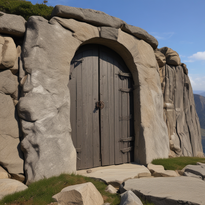
And the path we had followed led directly to the door step. At first, we thought it was a iron-bound wooden door, but upon closer inspection it seemed to be iron strips with iron hinges. As we looked closer, it seemed the iron strips were actually iron blocks a foot wide and about 15 feet long held in place vertically, by what we couldn’t determine. Something on the door’s interior, we presumed. We couldn’t see any signs of welding on the outside of the door, however. The door pieces were fitted very tightly together, so we couldn’t seen anything inside, as we had no flashlight. We also had no tools of any sort, as this was supposed to be a hiking and sightseeing trek!
The frame the door was mounted in seemed to be a solid block of granite, except at the top right side, where there appeared to be a separate piece of darker rock embedded about a foot deep into the top. We couldn’t determine if it served some purpose, or was just a repair of some type. Whomever built the door made it to last, as there was no sign of looseness or play. And believe me, we tried briefly to see if it could be opened!
There wasn’t a lock on the door, but in the center was a flat square iron piece about five inches in thickness, divided in half vertically, each piece mounted to each door half. Each half was scored with a groove around the outside edge, and in the groove was an iron bar about two inches in diameter that was wrapped tightly around the two halves. I can’t imagine the strength it would take to wrap an iron bar that tightly around the two halves! We thought it might have been heated with a torch, but there were no signs of discoloration from heating, and the iron showed no signs of rust. Even the door and hinges were not rusted in any way that we could determine.
What a mystery! We can only presume it was a mine from the early 1800’s as there is no historical evidence of mining earlier, except by Spaniard explorers before that. But, that raises several questions…
- Where did they get the enormous amounts of iron to create such a massive door, and how did they forge it in such a way as to prevent it rusting away?
- Why would someone expend such a gigantic effort in cutting steps (in many places) to get to the door in the first place?
- What’s behind the door that needed such careful attempts to make it inaccessible?
Bu the way, it needs mentioning that even though the door was not quite at the top of this particular peak, there really wasn’t all that much mountain behind the door, so how could it have been a very large mine. It would seem a huge effort for not much gain. Unless, the door had a steeply sloping tunnel behind it, or there were steps leading down behind. But if were a mine, why not start lower down on the mountain to access whatever was deemed so valuable. That can only be speculated upon.
I won’t bore you with our trip back down the mountain, except we had to take a different route back to avoid the steep wall with the foot/hand holes mentioned earlier, as we really didn’t wish to risk falling, especially as by this time we were very tired, hot and sweaty! And weariness can engender haste and mistakes, which we didn’t want, as we were rather far from any thought of medical help!
So, that’s it for this little adventure. Have a great day and may God Bless you and yours. Stay safe!
Footnotes
Global Positioning System↩︎